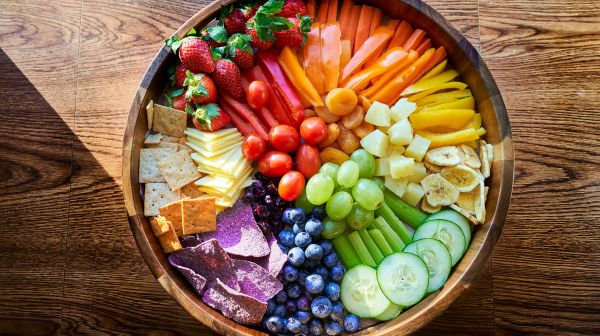
Healthy meals play a crucial role in overall well-being, but do you know that the color of your food can impact your health just as much as the ingredients themselves? Brightly colored fruits and vegetables are packed with essential nutrients, vitamins, and antioxidants that help fight diseases, boost energy levels, and support overall health.
Incorporating a variety of colors into your diet not only makes meals visually appealing but also ensures that you receive a broad spectrum of nutrients.
Many health services emphasize the importance of diverse diets filled with natural colors. The “Eat the Rainbow” concept encourages consuming different colored foods daily, each providing unique health benefits. We explores the power of colorful meals, the benefits of each color group, and practical ways to incorporate them into the diet.
The Science Behind Colorful Foods
The vibrant colors of fruits and vegetables are derived from phytonutrients, which are natural compounds that offer numerous health benefits. Each color represents a different type of phytonutrient with distinct properties.
Lycopene (Red) – Supports heart health and reduces the risk of cancer.
Beta-carotene (orange/yellow) enhances vision and boosts the immune system.
Chlorophyll (green) – Detoxifies the body and supports digestion.
Anthocyanins (blue/purple) improve brain function and fight inflammation.
Allicin (white/brown): Boost immunity and lowers cholesterol levels.
By consuming a variety of natural colors, one can ensure a balanced intake of essential nutrients that support optimal health. Many health services have recommended this approach to prevent chronic illnesses and promote longevity.
The Health Benefits of Eating a Rainbow Diet
1. Strengthens the Immune System
Colorful foods contain powerful antioxidants and vitamins that strengthen the immune system and reduce the risk of infections and illnesses. Vitamin C in citrus fruits, beta-carotene in carrots, and flavonoids in berries all contribute to robust defense mechanisms.
2. Improves Digestion and Gut Health
A diet rich in fiber from fruits, vegetables, and whole grains supports a healthy gut microbiome. Green leafy vegetables and fermented foods improve digestion, reduce bloating, and constipation.
3. Boosts Energy Levels and Mental Clarity

Natural sugars, fiber, and essential nutrients found in colorful foods provide energy throughout the day. For example, blueberries and nuts enhance cognitive function and improve memory.
4. Reduces Inflammation and Supports Heart Health
Chronic inflammation is associated with various diseases, including heart disease and arthritis. Colorful meals rich in omega-3 fatty acids, anthocyanins, and flavonoids help to combat inflammation and promote cardiovascular health.
Many health services have highlighted these benefits, encouraging individuals to adopt a nutrient-dense diet to enhance their overall well-being.
Breaking Down the Colors: What Each Hue Brings
🔴 Red Foods – Heart Health & Antioxidant Power
Examples: Tomatoes, strawberries, red bell peppers, watermelon
It contains lycopene and anthocyanins, which support heart health and reduce cancer risk.
Improved skin health and protection against UV damage.
🟠 Orange & Yellow Foods – Immunity & Eye Health
Examples: Carrots, mangoes, sweet potatoes, turmeric
It is packed with beta-carotene and vitamin C to boost the immune response.
Enhance vision and promote glowing of the skin.
🟢 Green Foods – Detox & Gut Health
Examples: Spinach, avocado, broccoli, kiwi
It is rich in chlorophyll, fiber, and folate, thus supporting detoxification.
Improve digestion and enhance brain function.
🔵🔮 Blue & Purple Foods – Brain Function & Anti-Aging
Examples: Blueberries, eggplant, purple cabbage, grapes
High in anthocyanins, which improve cognitive function.
Fight signs of aging and support for heart health.
🤍 White & Brown Foods – Immunity & Bone Strength
Examples: Garlic, onions, mushrooms, nuts
Contains allicin, fiber, and essential minerals.
Strengthen bones and support a healthy immune system.
How to Create the Best Colorful, Healthy Meals
1. Plan Your Meals with a Rainbow Mindset
The aim is to include at least three different colors in each meal. For example, salads with spinach (green), bell peppers (red), and carrots (orange) provide a diverse range of nutrients.
2. Experiment with Colorful Recipes
Try smoothie bowls, stir-fries, and grain bowls feature a variety of colorful ingredients. Adding herbs and spices such as turmeric or saffron can further enhance the nutrient profile.
3. Opt for Seasonal and Fresh Ingredients
Seasonal produce is fresher, flavorful, and packed with nutrients. Many health services recommend sourcing locally grown fruits and vegetables to maximize health benefits.
Common Myths About Eating Colorful Foods
1. “Colorful Eating is Expensive”
Although organic produce may be costly, eating a variety of colors does not have to be expensive. Local markets and frozen produce offer affordable options.
2. “Fruits Have Too Much Sugar”
Natural sugars found in fruits are beneficial in providing essential nutrients. Unlike refined sugars, they contain fiber, vitamins, and antioxidants.
3. “Artificial Colors are Just as Good”
Artificial food dyes lack the natural benefits of phytonutrients. Consuming real whole foods ensures that you have the most health advantages.
Practical Tips for Incorporating More Color into Your Diet
Make Smoothie Bowls – Blend colorful fruits like berries, bananas, and spinach for a nutrient-packed breakfast.
Try Rainbow Salads – Mix leafy greens, beets, oranges, and nuts for a visually appealing and healthy meal.
Switch Up Your Sides – Instead of white rice, try quinoa, purple sweet potatoes, or roasted carrots.
Use Herbs and Spices – Add turmeric, parsley, and paprika to meals for flavor and nutrition.
Follow Health Services Recommendations – Many experts suggest diversifying your plate for optimal nutrition.
Embrace the Rainbow for a Healthier You

Eating colorful, healthy meals is one of the simplest and most effective ways to improve your well-being. By incorporating a variety of hues into your diet, you can enjoy a balanced intake of essential nutrients, antioxidants, and vitamins. Many health services advocate for this approach as a way to enhance immunity, energy levels, and overall longevity